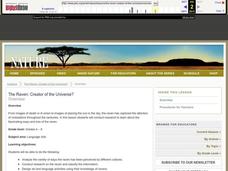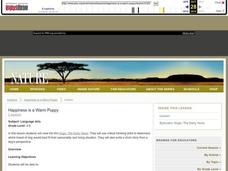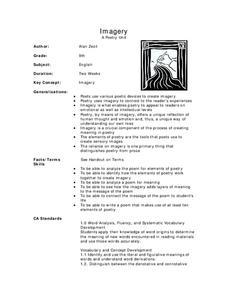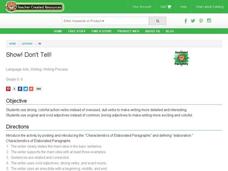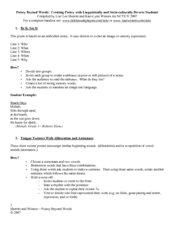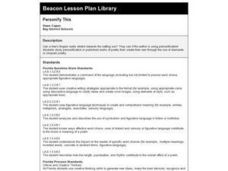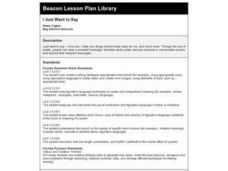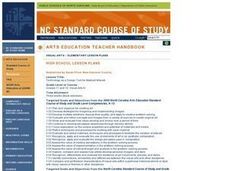Howard Hughes Medical Institute
Winogradsky Columns: Microbial Ecology in the Classroom
Winogradsky columns are ideal for observing the role of bacteria and other microorganisms in an ecosystem. This student activity guide is complete with data tables for observations and analysis questions for processing what was observed....
Museum of Tolerance
My Experience with Injustice
As part of their preparation for a visit to the Museum of Tolerance, individuals are asked to write about a time when they witnessed or experienced unjust, biased, or prejudicial treatment. A great way for writers to make a personal...
Kenan Fellows
Unit 4: The Brain
Drugs interact with the brain to alter moods, emotions, and behaviors by changing the brain's chemistry, perceptions, and interactions. The final lesson in the Pharmacology unit shows scholars experiments, has them complete four labs,...
Curated OER
Understanding Civilizations through Art
Young scholars research artwork, and create their own using their research as a model. They write a report on the importance of artwork in civilizations.
Curated OER
The Raven: Creator of the Universe?
Students explore biology by researching birds in class. In this raven identification instructional activity, students utilize the Internet to identify the anatomy, habits and habitat of ravens. Students write descriptive paragraphs about...
Curated OER
Happiness is A Warm Puppy
Students investigate dog breeds and write a short story from a dog's perspective. In this dog research and writing lesson, students watch the film, "Dog: The Early Years. They apply critical thinking skills to determine which type of dog...
Curated OER
Putting It Together
Students read aloud the book "Courage" by Bernard Waber and discuss the examples that compromise the defintion of courage. They describe another word such as joy and work with a partner or group to brainstorm and write sentences of...
Curated OER
Imagery
Ninth graders explore poems, various poetic devices, and identify imagery used in poetry. In groups, they examine poetic devices, define them, paraphrase and summarize poetry. Students study poetry by Robert Frost as they explore...
Curated OER
Show! Don't Tell!
Students write a descriptive paragraph. In this writing lesson, students define elaboration and discuss the characteristics of an elaborate paragraph. Students write a paragraph that contains vivid adjectives, strong verbs and exact nouns.
Curated OER
Poetry Beyond Words: Creating Poetry with Linguistically Diverse Students
Models of and directions for how to write 20 different types of poems are featured in an NCTE resource. The introduction to each form highlights the embedded concepts. For example, tongue twisters encourage poets to use alliteration and...
Curated OER
Enhancing Poetry with American Memories
Students explore poetry using American Life Histories: Manuscripts from the Federal Writers' Project. They compose their own unque "found poetry" based on the stories found in the collection.
Curated OER
Transforming Negatives to Positives
Students write diamonte poems that correspond to the double-exposed photograph they created. In this poetry and multimedia artwork lesson, students use the photographic process to create a double-exposed photo then create...
Curated OER
A Moment in Time
Eighth graders study poems to see how punctuation, line length, rhythm and word choice can be used to create a memorable moment. They read and discuss poems by Shel Silverstein.
Curated OER
Personify This
Eighth graders study personification in published works of poetry, then create their own through the use of diamante or cinquain poetry. They read and discuss poetry by Shel Silverstein, William Jay Smith, and Elinor Wylie.
Curated OER
I Just Want to Say
Eighth graders study poetic devices included in conversation poems and explore their eloquent messages. They read and discuss poems by Langston Hughes and Don Marquis.
Curated OER
I'm A Poet and Now I Know It
Eighth graders gather ideas generated from other poems and their own inspiration, to create original poetry. A celebration is included as students bind and submit poems for publication.
Curated OER
Teaching Selected Poems from Jim Wayne Miller's the Brier Poems
Students explore the basic elements of poetry through Appalachian life poetry. In this poetry lesson, students read seven poems from Jim Wayne Miller's the Brier Poems and complete poetry analysis activities for each poem.
Curated OER
Photojournalism
Students choose a historical or present-day event to portray through photographs. They narrate this event with photographs and text to communicate its significance in history or our current daily lives.
Curated OER
A Bug's Journey
Students research the art of John Baldessari. For this art history lesson, students examine Baldessari's drawing of a beetle and discuss the characteristics of these bugs. They write a story from a bug's perspective and create their own...
Curated OER
Technology as a Design Tool for self-portraits
Students create self-portraits using the technology of digital cameras mixed with other media. Adobe Photoshop is a requirement for this specific three week project. State standards for the arts are addressed.
Curated OER
Technology as a Design Tool for Abstract Artwork
Learners manipulate pictures using Adobe Photoshop and digital cameras to produce unique abstract works. This lesson can be modified to include a painting/mixed media element. State standards are addressed in this lesson.
Curated OER
Applied Science - Science and Math Lab
Students explore the senses. In this Applied Science lesson, students investigate the items in "feely" boxes with their hands, both touching the items and shaking the boxes to hear the sound the items make. Students also smell and taste...
Curated OER
See Spot Run
Young scholars identify several properties of water as a universal substance, describe the composition of several complex color mixtures and separate the components of dye using chromatographic technique.
Curated OER
"Chinese in the Frontier West: An American Story"
Learners substantiate a generalization by providing supporting details. They apply visual and oral information to a piece of written work and formulate at least three generalizations they think may characterize the experience of...
Other popular searches
- Sensory Images With Poems
- Sensory Images in Poetry
- Sensory Images in Writing
- Creating Sensory Images
- Sensory Images Comprehension
- Sensory Images Pilgrims






